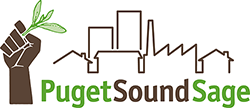
It is a widely held belief that economic development in an under-invested neighborhood inevitably – though regrettably – leads to the displacement of people of color, immigrants, refugees and low income people regardless of race.
“When a neighborhood is targeted for investment, people get pushed out and that’s just the way it is,” or so the story goes. This presumption is a dangerous and erroneous oversimplification of a very complex situation.
Gentrification alone does not necessarily cause displacement, but it creates the conditions for it. Largely by increasing the cost of living, gentrification creates a downward pressure on low-income residents. Without anywhere to gain an economic edge, low-income residents are eventually forced to seek housing elsewhere and are displaced from their neighborhoods.
But it doesn’t need to happen that way. Public policies can ensure that current residents benefit from economic growth and investments in their communities. See our article on Five Ways Seattle Policy Makers Can Promote Racial Equity in Southeast Seattle.
Unfortunately current gentrification trends in Southeast Seattle are likely to increase displacement pressures on communities of color. There are multiple factors that make Rainier Valley households more vulnerable to increases in the cost of living and therefore more susceptible for displacement .
- High percentage of renters: Renters comprise a significant number (44%) of Rainier Valley residents and the vast majority of people from Rainier Valley who live in poverty are renters (90%). Low-income renters are most vulnerable to increased costs in the housing market.
- High unemployment: Residents of Rainier Valley are unemployed at a rate 50% higher than the rest of Seattle.
- Low wage Jobs: Rainier Valley residents fall short in earnings compared to the rest of the city. Only 18% of residents earn more than $65,000 compared to Seattle as a whole, where over 46% of the population earns more than $65,000 annually.
- High foreclosure rate: Rainier Valley neighborhoods have experienced significantly higher rates of foreclosure than central and northern Seattle neighborhoods.
For more information about how gentrification trends are affecting South Seattle neighborhoods, read our full report Transit Oriented Development that’s Healthy, Green & Just.
